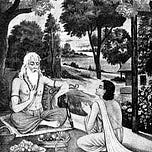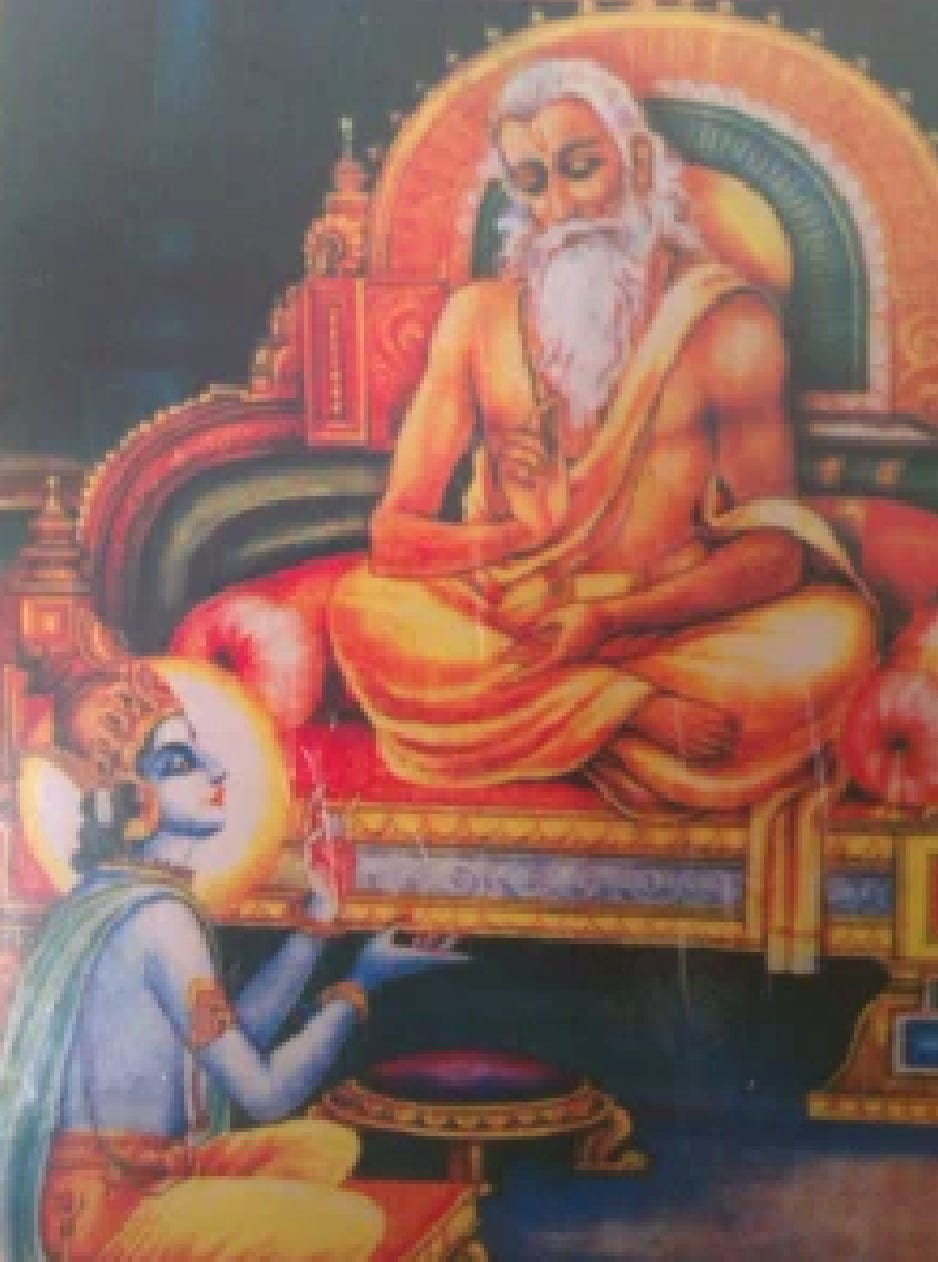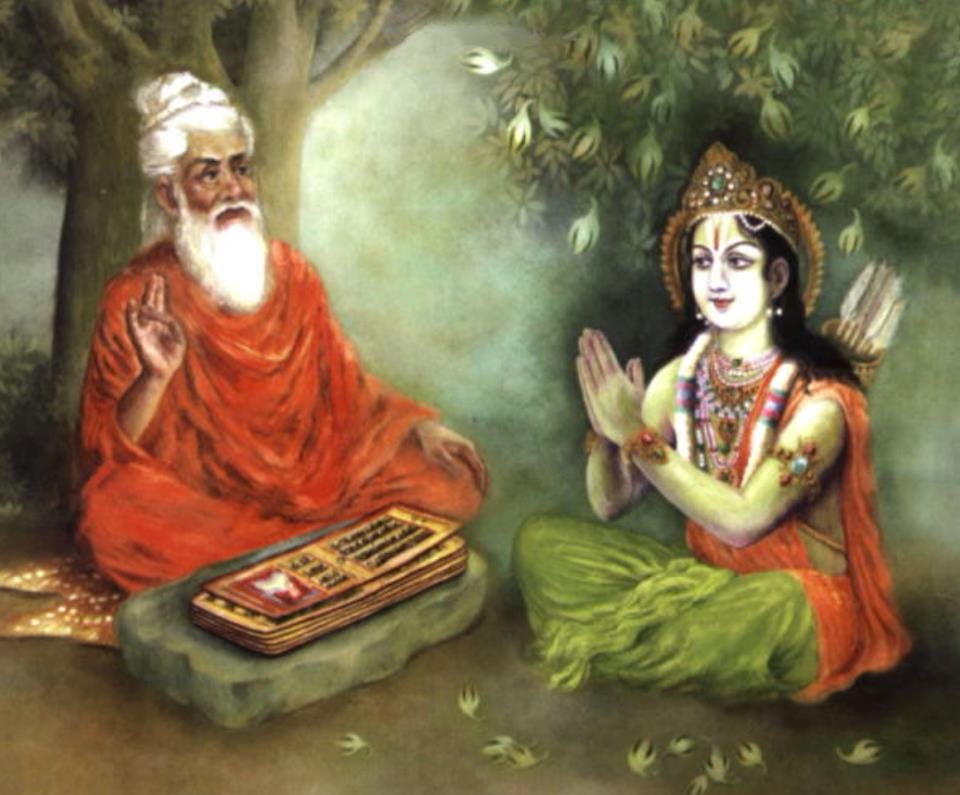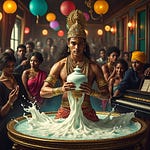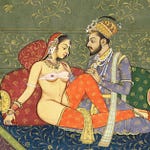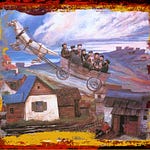Once upon a time, in a city that did not exist,
there were three princes who were brave and happy.
Of them, two were unborn, and one was not conceived.
Unfortunately, all of their relatives died,
and so the princes left their native city to go elsewhere.
Very soon, they fell into a swoon, unable to bear the heat of the sun.
Their feet were burned by hot sand. The tips of grass pierced them.
They reached the shade of three trees, of which two did not exist,
and the third was not even planted.
After resting there for some time and eating the fruits of those trees,
they proceeded further.
They reached the banks of three rivers; Two of them were dry
and in the third, there was no water.
The princes had a refreshing bath and quenched their thirst in them.
Then they reached a huge city, which was about to be built.
Entering it, they found three palaces of exceeding beauty.
Of them, two had not been constructed, and the third had no walls.
They entered the palaces and found three golden plates;
two of which had been broken,
and the third was pulverized.
They took hold of the one that had been pulverized
and took ninety-nine minus one hundred grams of rice and cooked it.
Then they invited three holy men to be their guests; Of them, two had no body,
and the third had no mouth.
After these holy men had eaten the food,
the three princes partook of the rest of it.
They were greatly pleased.
Thus, they lived in that city for a long time in peace and joy.
My child, this is an extremely beautiful legend
Pray, remember this always, and you will grow up into a learned man.
-Yoga Vashishtha
The Sage Vashishtha instructing young Rama
The previous story is taken from the Yoga Vasishta.
Recited by the sage Vasishta, it is part of his instruction to the young prince Rama
In this story, words and images clearly refer to things that cannot exist and
demonstrates why we can't explain anything, much less everything,
Further, it suggests the realization of this - 'Truth'
is directly related to being a 'Learned man!'
The Indian tradition was well aware of the limits of language as well as
the nature of the mind, words, and language. The Realization of what lay beyond
such ‘limits’ was the prerequisite for going beyond them.
These limits and that 'nature' are dramatized here in a delightful
participatory experience of how one non-existent thing
builds upon another as we find ourselves in a complex and interesting story.
This story is a demonstration of words referring only to themselves
and yet we still seem to have 'something' that we
understand and can even talk about.
Rather quickly, we are 'deluded' by the story
and no longer care whether it is true or not;
and this is a mirror of how we live our lives. . .
at the corner of the circle.
As my Teacher once said:
"It is better to understand the mind than to create philosophy with it. "
Adi Da -- Easy Death
At the age of less than 16 years, as a young prince of Ayodhya, Rama desired to view the kingdom he was to inherit from his father. After his brief tour of the world, the young king-to-be (Yuvaraj) returned to his palace, utterly disillusioned, having witnessed suffering in its many worldly forms.
The young Rama before his father, King Dasaratha
His father, King Dasaratha, worried that Rama would renounce the world, and he sought the advice of the Sage Vasistha.
The sage assured the King that Rama’s dispassion (vairagya) was not a cause for concern. Instead, it was a sign that Rama had begun to understand that life is full of suffering.
Vashishtha instructing the young prince Rama
Rama’s depression regarding the futility of existence was a positive disillusionment, the ancient prelude to the ‘desire for Liberation or mumukshutva, a necessary qualification for Revelation. Vashishtha recognized Rama’s readiness for Liberation, or that which goes beyond the suffering of the world. The instruction of Vashishtha begins with the ‘Understanding’ of both the world and mind.
“To the ignorant, the world is full of suffering, but in the vision of a knower of Truth, it is full of bliss.” - Yoga Vashishtha
Vashishtha instructing Rama
King Dasaratha summoned Rama to his court, where the sage, Vasishtha, began a discourse with the young prince that continued for 21 days. Vasishtha’s instruction and answers to Rama’s questions comprise the scripture known as ‘Yoga Vashishtha.’

